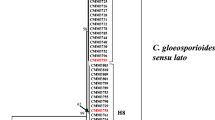Abstract
Five isolates of a species of Colletotrichum were collected from Japanese barnyard millet (Echinochloa utilis) in Japan. Although the fungus had once been identi-fied as C. graminicola sensu lato, it was clearly different from C. graminicola isolated from maize (Zea mays) in its falcate and short conidia, 18.0–22.2 μm in length, cultural characteristics, and specific pathogenicity to E. utilis. Moreover, molecular phylogenetic analyses using sequences of rDNA-ITS, HMG, and SOD2 indicated a monophyly of the isolates. A new species, Colletotrichum echinochloae, is then proposed based on the morphological, pathological, and molecular characteristics.
Similar content being viewed by others
References
Barhoom S, Sharon A (2007) Bcl-2 proteins link programmed cell death with growth and morphogenetic adaptations in the fungal plant pathogen Colletotrichum gloeosporioides. Fungal Genet Biol 44:32–43
Baxter AP, van der Westhuizen GCA (1984) A synoptic key to South African isolates of Colletotrichum. S Afr J Bot 3:265–266
Baxter AP, van der Westhuizen GCA, Eicker A (1983) Morphology and taxonomy of South African isolates of Colletotrichum. S Afr J Bot 2:259–289
Cesati V (1852) Klotzsch, herbarium vivum mycologicum, sistens fungorum per totam Germaniam cresentium collectionem peretam. Flora 35:398
Chen F, Goodwin PH, Khan A, Hsiang T (2002) Population structure and mating-type genes of Colletotrichum graminicola from Agrostis palustris. Can J Microbiol 48:427–436
Crouch JA, Clarke BB, Hillman BI (2006) Unraveling evolutionary relationships among the divergent lineages of Colletotrichum causing anthracnose disease in turfgrass and corn. Phytopathology 96:46–60
Du M, Schardl CL, Nuckles EM, Vaillancourt LJ (2005) Using mating-type gene sequences for improved phylogenetic resolution of Colletotrichum species complexes. Mycologia 97:641–658
Felsenstein J (1985) Confidence limits on phylogenies: an approach using the bootstrap. Evolution 39:783–791
Furukawa T, Kishi K (2002) Production of perithecia of various ascomycotina on water agar medium emended with leaf pieces. J Phytopathol 150:625–628
Holliday P (1980) Fungus diseases of tropical crops. Cambridge University, Cambridge
Holliday P (1989) A dictionary of plant pathology. Cambridge University, Cambridge
Hosoya T, Otani Y (1997) Hyaloscyphaceae in Japan (1): Nonglassy-haired members of the tribe Hyaloscypheaea. Mycoscience 38:171–186
Jamil FT, Nicholoson RL (1987) Susceptibility of corn to isolates of Colletotrichum graminicola pathogenic to other grasses. Plant Dis 71:809–810
Johnston PR, Jones D (1997) Relationships among Colletotrichum isolates from fruit-rots assessed using rDNA sequences. Mycologia 89:420–430
Kimura M (1980) A simple method for estimating evolutionary rates of base substitutions through comparative studies of nucleotide sequences. J Mol Evol 16:111–120
Le Beau FJ (1950) Pathogenicity studies with Colletotrichum from different hosts on sorghum and sugarcane. Phytopathology 40: 430–439
Mordue JEM (1967) Colletotrichum graminicola. CMI descriptions of pathogenic fungi and bacteria 132. Commonwealth Mycological Institute, Kew
Moriwaki J, Tsukiboshi T, Sato T (2002) Grouping of Colletotrichum species in Japan based on rDNA sequences. J Gen Plant Pathol 68:307–320
Nag Raj TR (1973) Genera coelomycetum. X. Ellisiella, Samukuta, and Sakireeta. Can J Bot 51:2463–2472
Nishihara N (1961) The results of alternate inoculation tests of graminicolous Colletotrichum species (in Japanese). Ann Phytopathol Soc Jpn 26:240–241
Saitou N, Nei M (1987) The neighbor-joining method: a new method for reconstructing phylogenetic trees. Mol Biol Evol 4:406–425
Sato T, Moriwaki J (2003) Plurivorous plant anthracnose fungus, Colletotrichum acutatum (in Japanese). MAFF microorganism genetic resources manual, no. 13. National Institute of Agrobiological Sciences Genebank, Tsukuba
Sherriff C, Whelan MJ, Arnold GM, Lafay JF, Brygoo Y, Bailey JA (1994) Ribosomal DNA sequence analysis reveals new groupings in the genus Colletotrichum. Exp Mycol 18:121–138
Sreenivasaprasad S, Mills PR, Brown AE (1996) Phylogeny and systematics of 18 Colletotrichum species based on ribosomal DNA spacer sequences. Genome 39:499–512
Sutton BC (1966) Development of fructifications in Colletotrichum graminicola (Ces.) Wils. and related species. Can J Bot 44:887–897
Sutton BC (1980) The Coelomycetes. Fungi imperfecti with pycnidia, acervuli and stromata. Commonwealth Mycological Institute, Kew, pp 523–537
Sutton BC (1992) The genus Glomerella and its anamorph Colletotrichum. In: Bailey JA, Jeger MJ (eds) Colletotrichum: biology, pathology and control. CAB International, Wallingford, pp 1–26
Swofford DL (2002) PAUP*: phylogenetic analysis using parsimony (*and other methods), version 4. Sinauer Associates, Sunderland, MA
Thompson JD, Gibson TJ, Plewniak F, Jeanmougin F, Higgins DG (1997) The Clustal X windows interface: flexible strategies for multiple sequence alignment aided by quality analysis tools. Nucleic Acids Res 24:4876–4882
von Arx JA (1957) Die Arten der Gattung Colletotrichum Corda (in German). Phytopathol Z 29:413–468
von Arx JA (1981) The genera of fungi sporulating in pure culture, 3rd edn. Cramer, Vaduz, pp 220–223
Weitzman I, Silva-Hunter M (1967) Non-keratinous agar media as substrates for the ascigerous state in certain members of the Gymnoascaceae pathogenic for man and animals. Sabouraudia 5: 335–340
White TJ, Bruns T, Lee S, Taylor J (1990) Amplification and direct sequencing of fungal ribosomal RNA genes for phylogenetics. In: Innis MA, Gelfand DH, Sninsky JJ, White TJ (eds) PCR protocols: a guide to methods and applications. Academic Press, New York, pp 315–322
Wilson GW (1914) The identity of the anthracnose of grasses in the United States. Phytopathology 4:106–112
Author information
Authors and Affiliations
Corresponding author
About this article
Cite this article
Moriwaki, J., Tsukiboshi, T. Colletotrichum echinochloae, a new species on Japanese barnyard millet (Echinochloa utilis). Mycoscience 50, 273–280 (2009). https://doi.org/10.1007/s10267-009-0485-1
Received:
Accepted:
Published:
Issue Date:
DOI: https://doi.org/10.1007/s10267-009-0485-1




